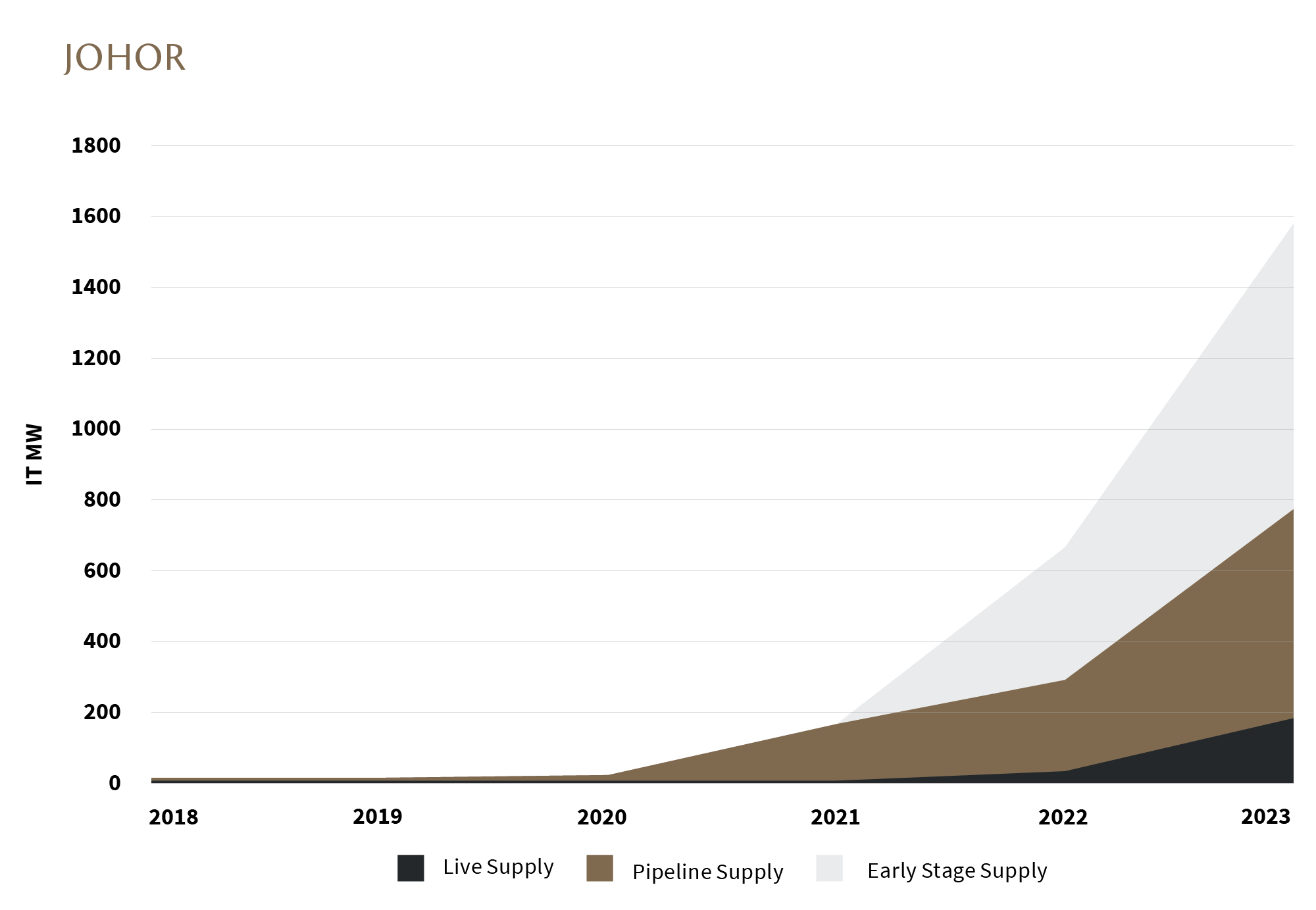The data centre goldrush is one of many trends playing out across Asia. Interested to understand more about the evolving economic landscape? King & Wood Mallesons is sponsoring the AFR Asia Summit – visit the event website for more information.
Johor sits at the southern tip of Malaysia, minutes away from neighbouring Singapore. Lesser known than the nation’s capital, Kuala Lumpur, and less developed than its most populous state of Selangor, Johor – and its capital Johor Bahru – are rapidly rising in prominence.
More than 300,000 people cross the one-kilometre causeway between Singapore and Johor each day, on average. But that’s not the (direct) cause of its rising status.
A ‘spillover’ zone for the vibrant but space-constrained economy of Singapore, Johor attracted US$9.5b in foreign direct investment in 2023. One development in particular is driving its changing fate: data centres.
From a reported live supply of 10MW four years ago, Johor has 1.6GW - 2GW of supply across early stage, pipeline and live capacity.
International operators and cloud service providers are starting to land bank in Johor in anticipation of future demand. Surrounding areas offering land with power are beginning to see intensifying interest.
What is happening in Johor is a microcosm of the rapidly unfolding scene of opportunities and challenges worldwide. Demand for data centre capacity is increasing exponentially, as artificial intelligence applications and cloud computing surge.
How to locate, build, power and cool data centres is emerging as a critical issue globally.
Across Southeast Asia, we’re seeing private capital taking more development risk on assets than they have in the past, with infrastructure becoming a key asset class – including greenfield data centres. Data centre investment and development is highly active across the region and a relative bright spot in several countries.
Adding complexity is the growing importance of ensuring data centres – existing and new - are sustainable. As the countdown to the next Conference of the Parties (COP) in Baku in November starts, stakeholder demands for green data centres will only get louder.
The International Energy Agency has called for additional government and industry efforts to increase energy efficiency and decarbonise the sector, halving emissions by 2030 to meet net zero economy goals. Data centres are responsible for 1 per cent of energy-related greenhouse gas emissions, with electricity consumption reaching 240–340 terawatt-hours (TWh) in 2022. To put it into perspective, that’s roughly the size of Australia’s total electricity generation and close to 5 to 6 times that of Singapore.
No surprise, then, that hyperscalers (the world’s largest cloud service providers) have become the biggest buyers of renewable power purchase agreements, with a mix of solar and wind power. For some data centres, a renewable power generator delivers electricity via a private transmission line not forming part of the national grid, for others, power is generated on site – such as rooftop solar.
Other private sector initiatives include the EU’s industrywide Climate Neutral Data Centre Pact and the 24/7 Carbon-free Energy Compact (including Google, Microsoft and Iron Mountain).
That’s a small snapshot of the global scene. In the APAC region, off-takers, consumers and some data centre operators are committing to green energy procurement as a mechanism to offset their environmental impact, with total data centre capacity expected to more than double by 2028 according to Moody’s.
Nicholas Moore AO’s report for the government, ‘Invested: Australia’s Southeast Asia Economic Strategy to 2040’, is a blueprint for the extraordinary opportunities – our strengths, our investment medal chances – in our neighbourhood. The challenge we face is moving on the advice it contains – and making similar bold moves elsewhere in our region, including Japan and Korea.
As a firm, we are right behind that initiative – both via our presence in the region, and through strong relationships with local firms. To understand and leverage opportunities, investors and dealmakers need to understand local markets – from regulatory settings and competitive dynamics to the possible impacts of policy decisions.
Read more about the M&A opportunities from David Friedlander, Renae Lattey and Michael Lawson here.
Despite the appetite and need for green power, transmission constraints and regulatory regimes are key blockers. In some cases, like Vietnam, there is a clear need for foreign capital. In others, the domestic market is strong and largely capable of going it alone – like the Philippines.
In Singapore, the data centre moratorium that saw developers turn to Malaysia and Indonesia is softly (and sustainably) lifting. The government – led by the Economic Development Board and the Infocomm Media Development Authority – allocates land and power for data centres in Singapore through ‘calls for application’. Any new data centres must meet stringent sustainability requirements, in addition to benefitting Singapore.
Others across Asia are moving to build – and ‘green’ – data centres, too.
In Japan, the government’s Green Growth Strategy includes a target for carbon neutral data centres by 2040. More broadly, the country wants non-fossil fuels to make up at least 59 per cent of energy generation by 2030, up from 26 per cent in 2022, and is spurring business investment in related areas. In January, a power purchase agreement was made for what will be Japan’s biggest solar power generation equipment – on a carport rooftop covering a dozen AEON retail stores.
And in Australia, where 17 subsea cables connect to Asia and the world, a new GreenSquareDC $1 billion data centre in Perth is powered by clean energy.
But back to Johor. As it continues to evolve as a data centre hub and high-value technology investment destination, it is poised to play a pivotal role in the digital transformation of Southeast Asia.
In Johor, the new-found home of a growing number of data centre parks, we see just how fast developments can happen. We see the game-changing potential of supportive policy and investment in a strategic location. As part of its broader goal to become a developed state by 2030, Johor has ventured into advanced manufacturing and semiconductors. To attract skilled labour and capital, the state has implemented initiatives that create favourable conditions including attractive settings and incentives.
Johor hints at ways to solve for power outages and water shortages, with the huge amounts of clean water needed for data centres often going under the radar when considered next to power issues. Regulators and other key stakeholders have developed the Johor Data Centre Development Planning Guidelines to promote sustainable development, including water-saving technologies, efficient power usage and renewable energy.
There’s also a general economy-wide drive for investment, with the Johor-Singapore Special Economic Zone agreed under a Memorandum of Understanding in early 2024 set to increase foreign direct investment. Renewable energy is a key focus of the Shenzhen-style zone, with Singapore and Johor working on cooperation frameworks including cross-border green electricity trading (the Shenzhen Special Economic Zone in China turned the city north of Hong Kong into a vibrant, high-tech financial centre).
More broadly, the Malaysian government is aiming for the digital economy to constitute a substantial portion of the country's gross domestic product by 2025. A dedicated Digital Investment Office supports data centre operators entering the market. With data centre energy demand accounting for 40 per cent of its national power generation capacity based on one industry estimate, the government has pushed to ensure they are green and investing in renewable resources like water to keep up with demand.
The types of projects emerging in Johor reflect the shift. Data centre clusters, such as Sedenak Tech Park, feature newly-installed rooftop solar. The YTL Green Data Centre Park, was set up in 2022 as a renewable-powered site. Microsoft is setting up a national AI Centre of Excellence and investing US$2.2b over four years in Malaysia - including Johor and Selangor.
Source: DCByte, Global Data Centre Index 2024

For all the positive developments, the Johor story is more green-lite than green light. A story of an opportunistic – and successful – move to capitalise on the moratorium next door. A story of data centre rags-to-emerging-Asian-hub-riches.
Johor is no shiny green beacon – there is much more to do. But there are clearly public and private sector efforts to build in sustainability at an early stage of Johor’s development as a data centre hub.
A mix of stakeholders must meet the IEA’s challenge to do more – across energy, infrastructure, real estate and government. Not just in Johor, but globally.
In the next couple of years, a fast light rail will reduce the journey from Singapore to Johor Bahru to five minutes, significantly increasing the number of people crossing the Straits of Johor each day. Johor is more than a destination for Singaporeans seeking less expensive housing, or a trip to its Legoland. It’s a jurisdiction to watch as it chases modern-day prospectors in the data centre goldrush – and hopefully, ultimately, greenrush.
Guiding you through the complexities of the digital landscape.





